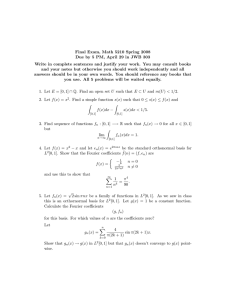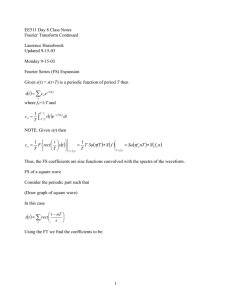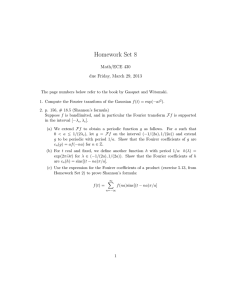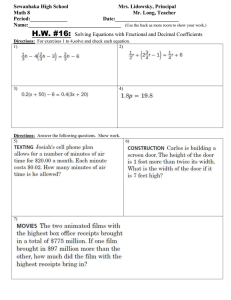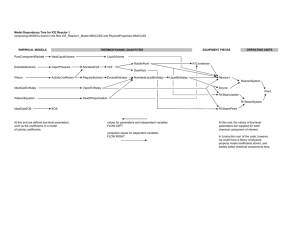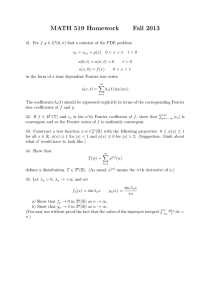Assignment 3
advertisement
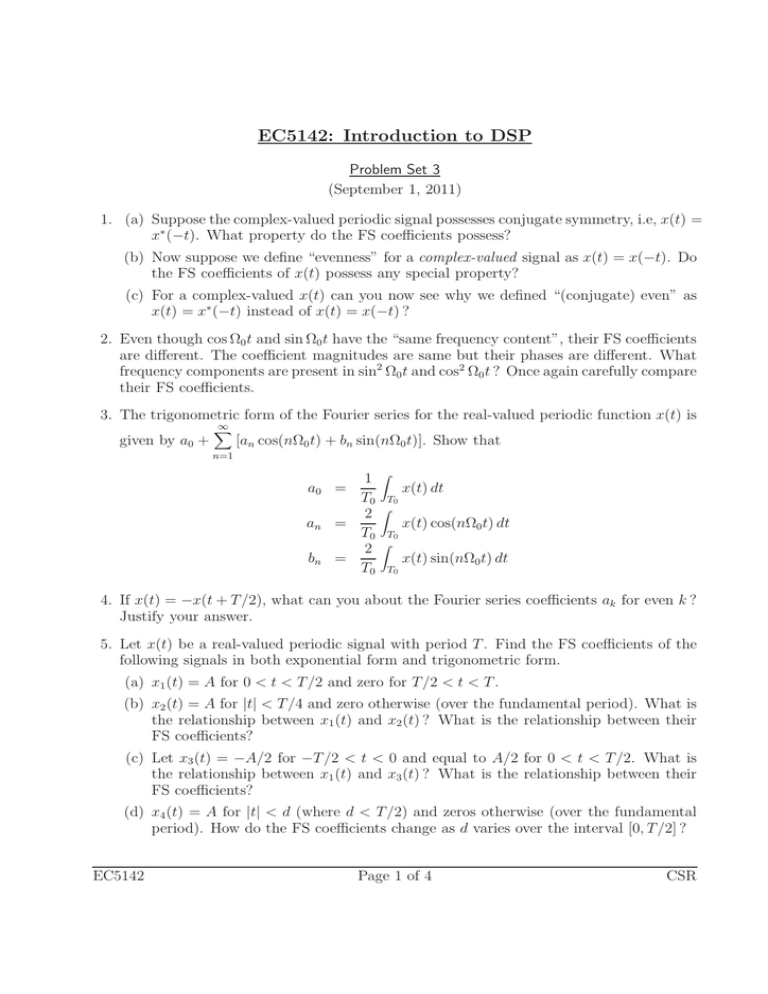
EC5142: Introduction to DSP Problem Set 3 (September 1, 2011) 1. (a) Suppose the complex-valued periodic signal possesses conjugate symmetry, i.e, x(t) = x∗ (−t). What property do the FS coefficients possess? (b) Now suppose we define “evenness” for a complex-valued signal as x(t) = x(−t). Do the FS coefficients of x(t) possess any special property? (c) For a complex-valued x(t) can you now see why we defined “(conjugate) even” as x(t) = x∗ (−t) instead of x(t) = x(−t) ? 2. Even though cos Ω0 t and sin Ω0 t have the “same frequency content”, their FS coefficients are different. The coefficient magnitudes are same but their phases are different. What frequency components are present in sin2 Ω0 t and cos2 Ω0 t ? Once again carefully compare their FS coefficients. 3. The trigonometric form of the Fourier series for the real-valued periodic function x(t) is given by a0 + ∞ X [an cos(nΩ0 t) + bn sin(nΩ0 t)]. Show that n=1 a0 an bn Z 1 = x(t) dt T0 T0 Z 2 x(t) cos(nΩ0 t) dt = T0 T0 Z 2 = x(t) sin(nΩ0 t) dt T0 T0 4. If x(t) = −x(t + T /2), what can you about the Fourier series coefficients ak for even k ? Justify your answer. 5. Let x(t) be a real-valued periodic signal with period T . Find the FS coefficients of the following signals in both exponential form and trigonometric form. (a) x1 (t) = A for 0 < t < T /2 and zero for T /2 < t < T . (b) x2 (t) = A for |t| < T /4 and zero otherwise (over the fundamental period). What is the relationship between x1 (t) and x2 (t) ? What is the relationship between their FS coefficients? (c) Let x3 (t) = −A/2 for −T /2 < t < 0 and equal to A/2 for 0 < t < T /2. What is the relationship between x1 (t) and x3 (t) ? What is the relationship between their FS coefficients? (d) x4 (t) = A for |t| < d (where d < T /2) and zeros otherwise (over the fundamental period). How do the FS coefficients change as d varies over the interval [0, T /2] ? EC5142 Page 1 of 4 CSR (e) x5 (t) is similar to x1 (t) except that it is defined to be A for 0 ≤ t ≤ T /2 and zero for T /2 < t < T . Do the FS coefficients change? Ponder about the equality sign in the expression x(t) = ∞ X ak ejkΩ0 t . k=−∞ 6. Signal symmetry imposes some properties on the Fourier series coefficients. Verify the properties given in the table below, in which entries such as a0 6= 0 and b2n+1 6= 0 are to be interpreted to mean that these coefficients are not necessarily 0 but may be so in specific examples. Symmetry Even Odd Half-wave odd Table 1: Effects of Symmetry a0 an bn Remarks Integrate over T /2 only, and a0 6= 0 an 6= 0 bn = 0 multiply the coefficients by 2 Integrate over T /2 only, and a0 = 0 an = 0 bn 6= 0 multiply the coefficients by 2 a = 0, b = 0, Integrate over T /2 only, and 2n 2n a0 = 0 a2n+1 6= 0 b2n+1 6= 0 multiply the coefficients by 2 7. Let x1 (t + T ) = x1 (t) and x2 (t + T ) = x2 (t). The Fourier series coefficients of x1 (t) are Z 1 x1 (t) · x2 (t) dt in terms given by ck , whereas those of x2 (t) are given by dk . Express T T of ck and dk . 8. Find the Fourier series representation of (a) |sin 2πt| (full-wave rectified sine), and (b) sin 2πt for 0 ≤ t ≤ 0.5 and 0 for 0.5 ≤ t ≤ 1 (half-wave rectified sine). 9. x(t) is periodic with period T and linearly increases from x(0) = 0 to x(T ) = E. (a) Find its Fourier series expansion in both exponential and trigonometric forms. (b) Find the FS coefficients of dx(t)/dt, making sure to take care of any impulses that may be present. Knowing the coefficients of dx(t)/dt, can you find those of x(t)? 10. y(t) is such that y(t + T ) = y(t), and linearly falls from y(−T /2) = 3E to y(T /2) = E. Find its FS coefficients without explicitly computing them; instead, derive them using the result from the previous problem and using properties of Fourier series. 11. A series combination of 1 Ω and 1 F is excited by a periodic square wave with period 1 s. At t = 0.5 the input voltage switches from E0 to −E0 . Find the FS expansion of the loop current i(t) under steady-state conditions. Express the power dissipated in the circuit as a sum of harmonic components. 12. Let x(t) = sin(2πf0 t) for 0 ≤ t ≤ 0.1 seconds and zero for 0.1 < t ≤ 0.9 seconds; x(t + 1) = x(t). Find that frequency component with the largest spectral magnitude. EC5142 Page 2 of 4 CSR 13. One period of a triangular wave is given in the figure below. Compute its Fourier series coefficients in both exponential and trigonometric forms. How do the ak fall off with increasing k? Compare its rate of fall with that of a periodic square wave. x(t) A t − T20 T0 2 −A 14. (a) Let x(t) = ∞ X δ(t − kT ). Plot x(t). Find its FS coefficients in both exponential k=−∞ and trigonometric forms. (b) Let x(t) = 1 for t = 0, ±T, ±2T, . . . and zero otherwise. Find the FS coefficients in both exponential and trigonometric forms. 15. Walsh functions are a set of orthogonal functions defined over the interval [0, 1) that take on the values of ±1. These functions are characterized by their sequency, which is defined as one-half the number of zero-crossings of the function over the interval [0, 1). The first few Walsh basis functions are shown in the figure below. wal0 (t) wal1 (t) wal2 (t) wal3 (t) t 0 1 4 1 2 3 4 1 (a) Verify that the Walsh functions are orthogonal over [0, 1). EC5142 Page 3 of 4 CSR (b) Suppose we wish to represent x(t) = t [u(t) − u(t − 1)] in terms of the following Walsh function expansion: X x(t) = ck walk (t) k Find the coefficients ck for k = 0, 1, . . . , 6. Repeat for (a) x(t) = sin 2πt, and (b) x(t) = wal3 (t). 16. Computer Experiment The Fourier X series representation of a square wave with halfwave odd symmetry is given by (1/k) sin(kt). The aim of this exercise is to k=1,3,5,... plot the partial sums and see how the series converges at a discontinuity. Define t=(0:1e-4:2*pi)’; (use %pi in Scilab). The following lines of code compute the partial sums: N=5; x=zeros(62832,1); for k=1:N, x = x + 1/(2*k-1)*sin((2*k-1)*t); end. Plot the results for various values of N and observer the behaviour. In particular, note the height of the overshoot. 1 . To this we 1 + jΩRC feed an odd-symmetric unit amplitude square wave with period T0 = 1, having Fourier series coefficients ak (which you should compute analytically). The output y(t) = P a H(kΩ 0 ) exp(jkΩ0 t). Make the number of terms in the sum to be a variable L. k k Let RC = 0.2 and 0.05. Plot one period of the output for different values of L. If the value of RC is very large (e.g., 2), what is the shape of the output? What operation has the circuit performed on the input in this case? Observe how the shape depends on the number of terms in the summation. In particular, what is the dependence of the sharpness of the corners on the number of terms? 17. Computer Experiment For an RC lowpass filter H(Ω) = Compare these results by convolving numerically a 10-second square wave train with h(t) = 1/(RC) exp(−t/RC) u(t). A 10-second square wave can be easily constructed by first defining t=(-0.5:0.001:0.499)’; and getting one period by x1=sign(t); (sign is a Matlab/Scilab function). Next compute tmp=x1*ones(1,10). The ten columns of tmp are identical and equal to x1. Form the periodic signal xp by xp=tmp(:); which stacks all the columns into a single vector. Verify the result by plot((-5:0.001:4.999)’,xp). In the convolution output observe the pulse shapes at the beginning, middle, and ending portions. Repeat the experiment for an RC highpass filter (output is taken across the resistance). Repeat all of the above when the input is a triangular wave. EC5142 Page 4 of 4 CSR
